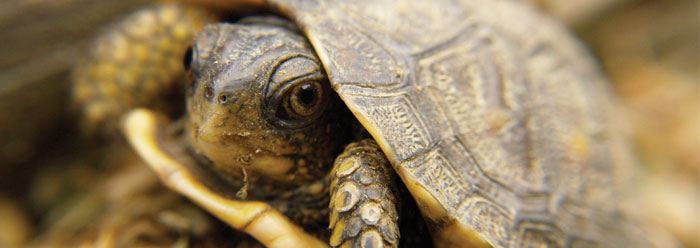 Follow
the Eunotosaurus: An Evolutionary Shell Game? By Brian
Thomas, M.S. *
Follow
the Eunotosaurus: An Evolutionary Shell Game? By Brian
Thomas, M.S. *
Evolutionary biologists face a challenge when trying to explain how the first turtle evolved. Accordingly, evolution had to incrementally restructure some kind of lizard into a turtle using gradual stages over millions of years, all the while preventing any vital disruptions to its basic bodily functions. Scientists reported in Current Biology their description of "a critical transitional form in the evolution of the turtle body plan" to help solve the huge problem of turtle origins by evolution.1 Do the fossil data actually back this claim?
The researchers described fossil material from an extinct turtle named Eunotosaurus. In order for it to qualify as a transitional form, it should show at least one transitional core feature. Core, because variations in non-critical features like numbers of fingers or length of tail could simply be due to variations within a created kind or within a species.
A real evolutionary transition—morphing between kinds—should show an in-between critical feature, like muscle attachment points half way between lizard and turtle, or ribs that were still flexible enough to permit reptile-like breathing, yet part-way stiffened like the turtle's. What were Eunotosaurus' telling transitional features?
The study authors wrote that it "only differs from undisputed stem turtles…in sharing fewer derived characters with crown turtles."1 "Stem turtles" denote evolutionary ancestors, "derived characters" describe body features supposedly inherited from those hypothetical stem turtles, and "crown turtles" refer to modern turtles, which have all their proper turtle parts in place.
Possessing fewer features which some evolutionists might consider "derived" is not at all the same as having at least one transitional core feature.
Also, all three quoted phrases are entirely subjective! One researcher could reassign a "stem turtle" to "evolutionary dead end" status, or swap a "derived character" for a "coevolved" character at any time and for any number of reasons. Indeed, secular scientific literature is filled with just such assertions and counter-assertions. It appears that Eunotosaurus' transitional status rests on little more than a few conjectures.
So if Eunotosaurus was not "a critical transitional form," then what was it? The study compared a range of fossil turtle anatomy details to provide the answer: "There is strong support for a turtle + Eunotosaurus clade [group]."1 Is that very different than just saying, "Eunotosaurus was a turtle?"
Not only was this just a turtle with no transitional core feature, but it even looked fully formed, as though all its proportionally fitted parts were put together in order to work together.2 Eunotosaurus already had the organization of leg and breathing muscles unique to turtles, inferred by muscle attachment points seen on its fossilized bones.3 By failing to showcase even one transitional core feature, this particular fossil best fits the creation model, which proposes that God created turtles to reproduce after their kind—not between different kinds.
References
- Lyson, T. R. et al. 2013. Evolutionary Origin of the Turtle Shell. Current Biology. 23: 1-7.
- In what could be translated as, "The evidence shows that this fossil turtle's shell originated suddenly, by direct creation," the Current Biology authors wrote, "The lack of osteoderms [bony plates embedded in skin, unconnected to the skeleton] in the recently discovered stem turtle Odontochelys semitestacea strongly supports the de novo model of shell origination…"
- No evolutionist has yet proposed a detailed hypothetical series of transitions between lizard-breathing and turtle-breathing anatomy, let alone constructing and testing models or finding appropriate transitions among fossils. Instead, hand-waving magic words like "reorganization" by "evolution" substitute for actual evidence.
* Mr. Thomas is Science Writer at the Institute for Creation Research.